Trigonometry, Conics, and Precalculus
NOTE: If you are using Internet Explorer and are unable to download the .zip activity files, right-click the download link and choose Save Target As to save to your computer.
 A Sine Wave Tracer
A Sine Wave Tracer
Students use points on perpendiculars, parallels, and a circle to construct an animation that traces out a sine wave. They explore the sine wave by dragging various points in their construction. Finally, students explore the relationship between a unit circle, its circumference, and the trace of a sine wave.
View Overview  | Download Activity Files (.zip)
| Download Activity Files (.zip)
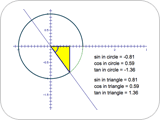 Unit Circle and Right Triangle Functions
Unit Circle and Right Triangle Functions
Students explore the relationships between the unit circle definitions of trigonometric functions and the right triangle definitions. They then combine the two models and examine the similarities and differences that emerge.
View Overview  | Download Activity Files (.zip)
| Download Activity Files (.zip)
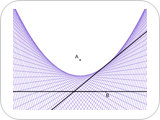 Patty Paper Parabolas
Patty Paper Parabolas
Students fold a piece of paper so that the creases outline the shape of a parabola. They compare their parabolas with those of other students to see how the shape depends on the positions of the focus and directrix. Students then do the same construction with Sketchpad and explore how moving the focus or directrix changes the shape of the folds. Finally students are challenged to construct the parabola itself (not just the folds) and to prove that their construction matches the geometric locus definition of a parabola.
View Overview  | Download Activity Files (.zip)
| Download Activity Files (.zip)
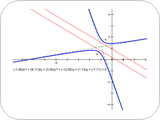 Analytic Conics
Analytic Conics
Students explore conic sections analytically. They change parameters in the equation of a conic in standard position and observe changes in the graph, and then explore the general equation of a conic section.
View Overview  | Download Activity Files (.zip)
| Download Activity Files (.zip)
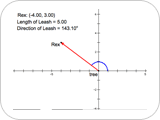 Introduction to Vectors: Walking Rex
Introduction to Vectors: Walking Rex
Students learn two ways to describe vectors, convert between the two descriptions, and move vectors around the plane to explore how vectors are independent of specific positions.
View Overview  | Download Activity Files (.zip)
| Download Activity Files (.zip)
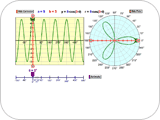 Cartesian Graphs and Polar Graphs
Cartesian Graphs and Polar Graphs
Students compare rectangular graphs and polar graphs for functions in the form y = a sin(bx) and r = a sin(bθ). They find connections between the two types of graphing when they analyze how the period and amplitude of a Cartesian graph correlate with features of the corresponding polar graph. They make predictions as to how changing a and b will affect the polar graph and then check their predictions.
View Overview  | Download Activity Files (.zip)
| Download Activity Files (.zip)
Back to Sample Activities







